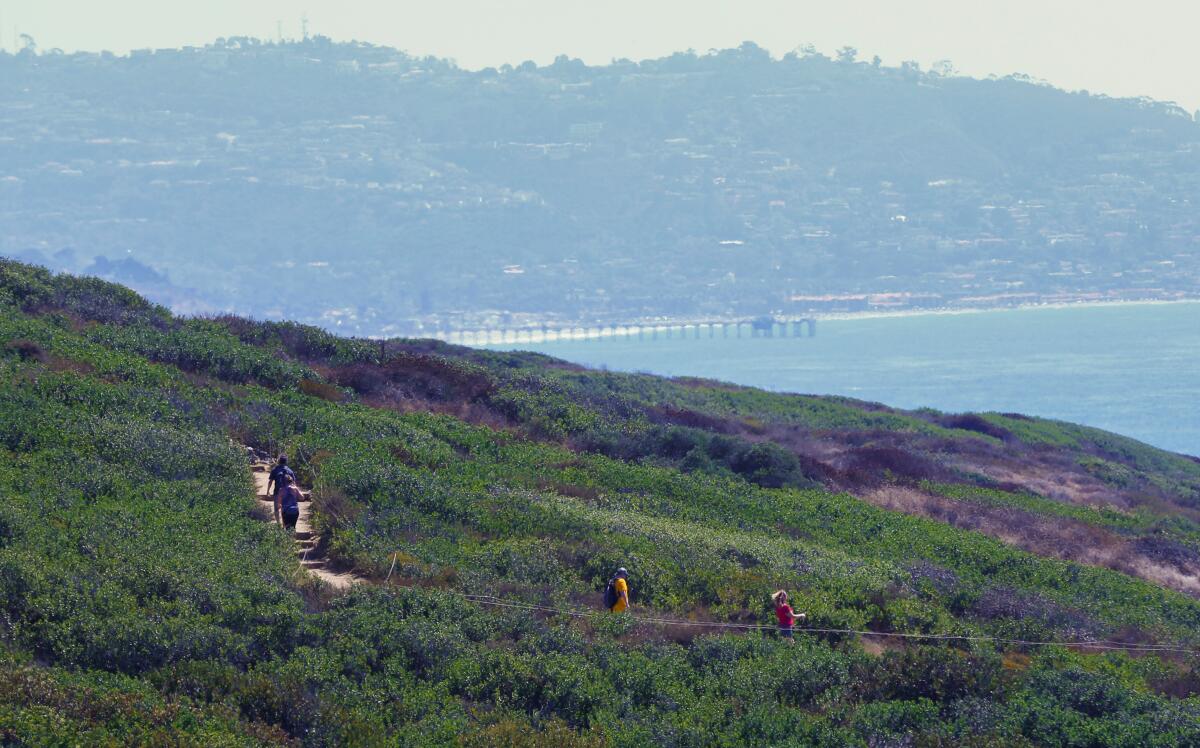Easy tips to help you become an environmentally aware traveler

Oceans are warming, permafrost is thawing and wildfires keep burning.
As the 50th anniversary of Earth Day approaches (April 22), how can we, as travelers, be better stewards of Mother Earth?
Should we heed environmentalists who shout “Stop traveling”?
I would sooner stop breathing.
Travel is powerful and can make us better, more enlightened people (except when there’s a jerk in the seat next to me).
But we must reduce the carbon emissions, food impact and single-use plastic waste resulting from our travel.
Here’s what experts told me:
Research/planning
Choose your destination based on trip length. Stay closer to home to minimize carbon emissions.
• Don’t fly if you can avoid it, but if you must fly, stay longer.
• Explore the U.S. if you have limited vacation time. California has nine national parks and 278 state parks, plus national forests. Or enjoy the 49 other states, the District of Columbia and the five inhabited territories.
• Choose airlines focused on sustainability. For example, JetBlue plans to go carbon-neutral on its domestic flights beginning in July. Delta, Qantas, Air New Zealand and Lufthansa specify environmental goals and sell carbon offsets.
• Explore the U.S. if you have limited vacation time. We have national park units (nine in California, the most of any state), and 278 state parks, plus national forests and 50 states to enjoy plus five inhabited territories.
• Fight overtourism. “When selecting where to travel ... go off the beaten path to share the tourism benefits with destinations in need,” James Thornton, chief executive of Intrepid Travel, a tour operator known for sustainability, said in an email. Avoid popular destinations such as Venice, Italy, and the seaside resorts of Sihanoukville, Cambodia, “that are negatively impacted by crowds they can’t sustain.”
• Fight undertourism. “There are emerging destinations that are crying out for visitors,” said Gavin Tollman, chief executive of tour company Trafalgar. Consider, for instance, visiting Georgia, Armenia or the Balkans.
• Buy carbon offsets to mitigate greenhouse gases generated by your trip. “The key things to seek in an offset are that it is verifiable, enforceable, permanent and additional; it wouldn’t happen otherwise,” said Peter Miller, a climate and energy scientist for the Natural Resources Defense Council.
• Take public transportation. Amtrak has partnered with Carbonfund, a nonprofit carbon offsetter. FlixBus, the hip, app-oriented German bus company, offers carbon offsets through the nonprofit atmosfair.
• Choose sustainable hotels that are LEED-certified for environmental stewardship.
• Take electric cars on road trips. Rental car companies, including Enterprise and Hertz, and car-sharing company Turo also rent electric vehicles.
• Choose sustainable hotels, preferably LEED-certified for environmental stewardship by the U.S. Green Building Council. The Shore Hotel (gold) and the Ambrose Hotel (silver) in Santa Monica, the Source Hotel (silver) in Denver and numerous Marriott hotels are LEED-certified.
• Buy sustainably made garments from earth-friendly companies such as Patagonia and Toad&Co.
• Pack light. Instead of packing snow clothes, rent a ski jacket or pants from Patagonia in Denver through its partnership with Awayco, a gear-rental company started by surfers wanting to avoid clutter and baggage fees. In the L.A. area, you can rent surfboards.
• Choose luggage made from repurposed, recycled or upcycled materials. Looptworks, a Portland-based upcycler, has repurposed Southwest and Alaska airlines’ leather seat covers and Delta uniforms into backpacks, totes and more. L.A.-based Rewilder makes bags from repurposed industrial trash, including beer filter cloth and scrap airbag fabric.
• Carry a reusable water bottle. If you wind up without yours, buy a refillable aluminum bottle like PathWater, which is designed for reuse.
• Prepare and pack snacks in reusable containers for your flight to avoid creating single-use waste in airports and on airplanes.
Soft footprints
• Choose tour operators aligned with the principles of the organization Leave No Trace, whose website says it provides the “framework of minimum impact practices for anyone visiting the outdoors.” Along with Intrepid Travel and Trafalgar, Great Explorations (biking, hiking and other tours), Randonnèe (self-guided cycling and walking tours) and Northwest Rafting Co. contributed tips.

• Use human power. Zachary Collier, river guide and co-owner of Northwest Rafting, said: “Do a trip that doesn’t require vehicles: backpacking, floating or biking.”
• Use reef-safe sunscreens to protect coral from harmful chemical sunscreens.
• Heed Colorado’s Leave No Trace — Care for Colorado rules: Stick to trails; pack out your trash; leave nature as you find it.
• Go vegan or vegetarian for some meals; livestock are hard on the environment.
More to Read
Sign up for The Wild
We’ll help you find the best places to hike, bike and run, as well as the perfect silent spots for meditation and yoga.
You may occasionally receive promotional content from the Los Angeles Times.






